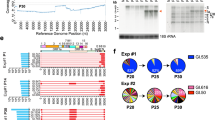Summary
In an effort to enhance genetic interactions by eliminating spatial or physical barriers between variants of Sindbis virus, MgCl2 was used to aggregate infecting viral particles. Mixing viral samples in a 1:1 ratio with 0.5m MgCl2 produced maximal reduction in plaque forming units (PFU) with minimal cell damage due to MgCl2. Aggregate size was determined to be about 7 PFU. Samples taken at 3, 5 and 10 hours after infection with mixed aggregates composed of large and small plaque forming virus indicated that only one type of genome was represented among the progeny particles. In addition, aggregation enhanced complementation and the progeny were stable after several cycles of sonication and passage.
Similar content being viewed by others
References
Arif, B. M., Faulkner, P.: Genome of Sindbis virus. J. Virology9, 102–109 (1972).
Burge, B. W., Pfefferkorn, E. R.: Isolation and characterization or conditional-lethal mutants of Sindbis. Virology30, 204–213 (1966a).
Burge, B. W., Pfefferkorn, E. R.: Complementation between temperature-sensitive mutants of Sindbis virus. Virology30, 214–233 (1966b).
Cooper, P. D.: Homotypic non-exclusion by Vesicular Stomatitis virus in chick cell culture. J. gen. Microbiol.19, 350–364 (1958).
Dulbecco, R.: Production of plaques in monolayer tissue cultures by single particles of an animal virus. Proc. Nat. Acad. Sci.38, 747–752 (1952).
Granoff, A.: Studies on mixed infection with Newcastle Disease Virus. II. The occurrence of Newcastle virus heterozygotes and study of phenotypic mixing involving serotype and thermal stability. Virology9, 649–670 (1959).
Grimley, P. M., Berezesky, I. K., Friedman, R. M.: Cytoplasmic structures associated with an arbovirus infection: Loci of viral ribonucleic acid synthesis. J. Virol.2, 1326–1338 (1968).
Hunt, J. M., Marcus, P. I.: Mechanism of Sindbis virus-induced intrinsic interference with Vesicular Stomatitis virus replication. J. Virol.14, 99–109 (1974).
Johnston, R. E., Bose, H. R.: A viral gene required for the induction in Sindbis virus interference. Abs. Ann. Meet. Amer. Soc. Microbiol. p. 208 (1973).
Marcus, P. I., Carver, D. H.: Intrinsic interference: a new type of viral interference. J. Virol.1, 334–343 (1967).
Pringle, C. R., Duncan, I. B., Stevenson, M.: Isolation and characterization of temperature-sensitive mutants of Vesicular Stomatitis virus, New Jersey serotype. J. Virol.8, 836–841 (1971).
Taylor, R. M., Hurlbut, H. S., Work, T. H., Kingston, J. R., Frothingham, T. E.: Sindbis virus: a newly recognized arthropod-transmitted virus. Amer. J. trop. Med. Hyg.4, 844–862 (1955).
Yarus, M., Sinsheimer, R. L.: The process of infection with bacteriophage ØX 174. XIII. Evidence for an essential bacterial “site”. J. Virol.1, 135–144 (1967).
Author information
Authors and Affiliations
Additional information
With 6 Figures
Rights and permissions
About this article
Cite this article
Brawner, T.A., Steglich, C. & Sagik, B.P. Genetic exclusion and stable complementation of Sindbis virus. Archives of Virology 50, 177–187 (1976). https://doi.org/10.1007/BF01320571
Received:
Accepted:
Issue Date:
DOI: https://doi.org/10.1007/BF01320571




